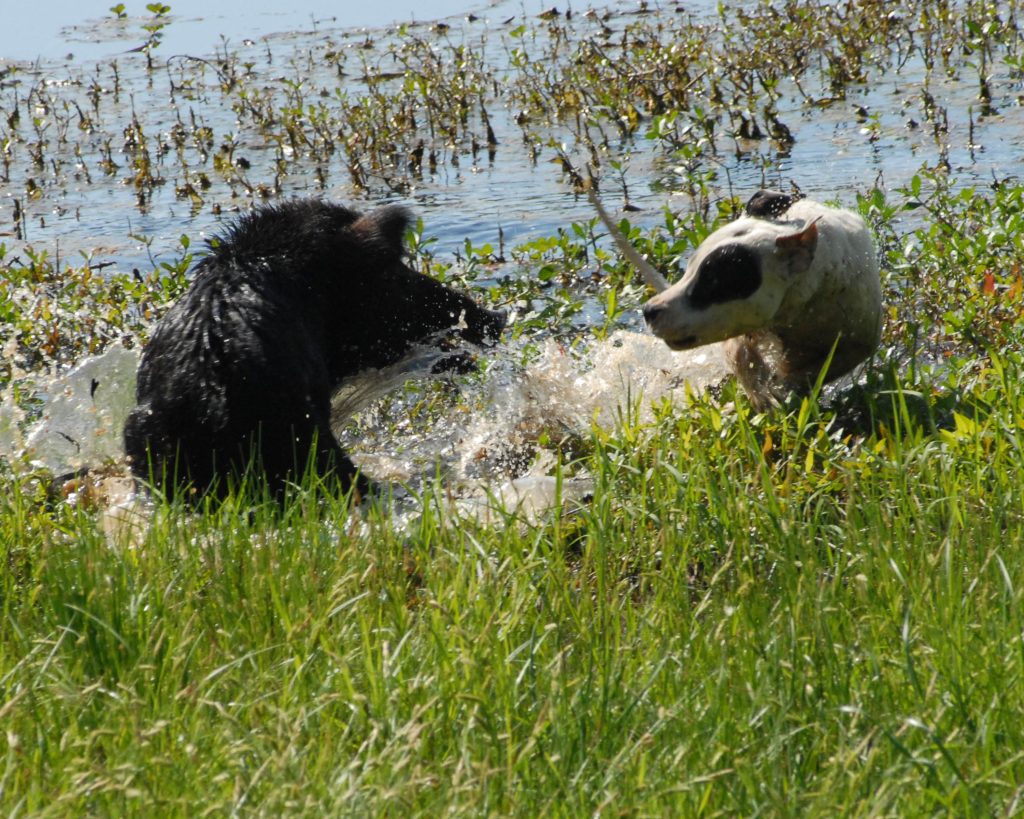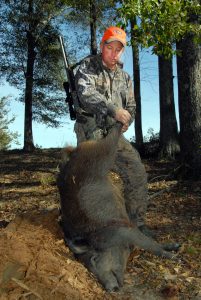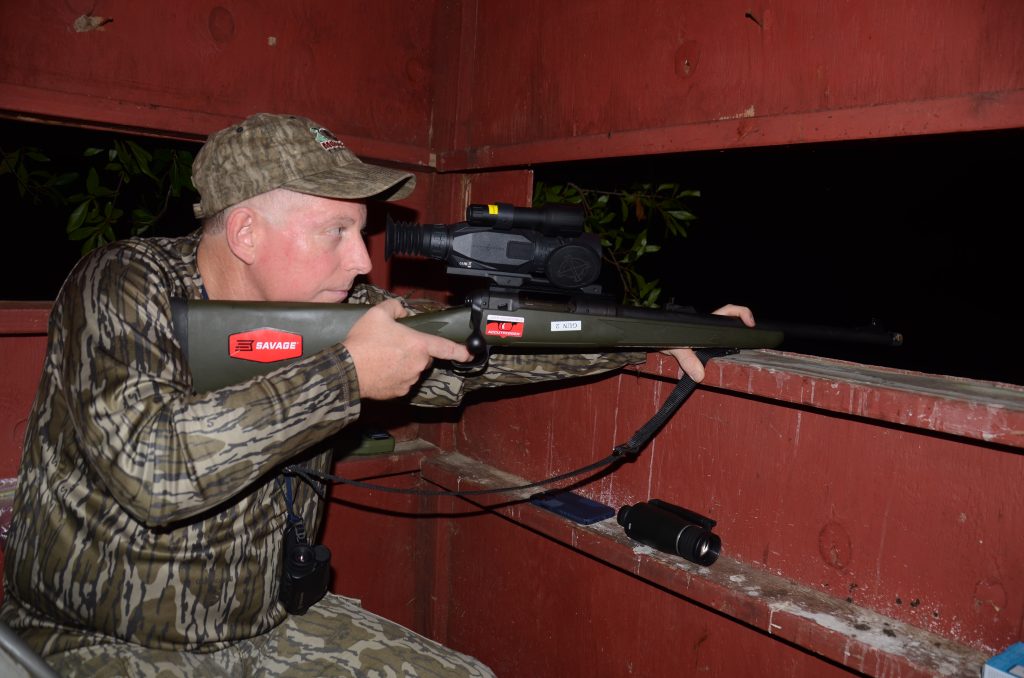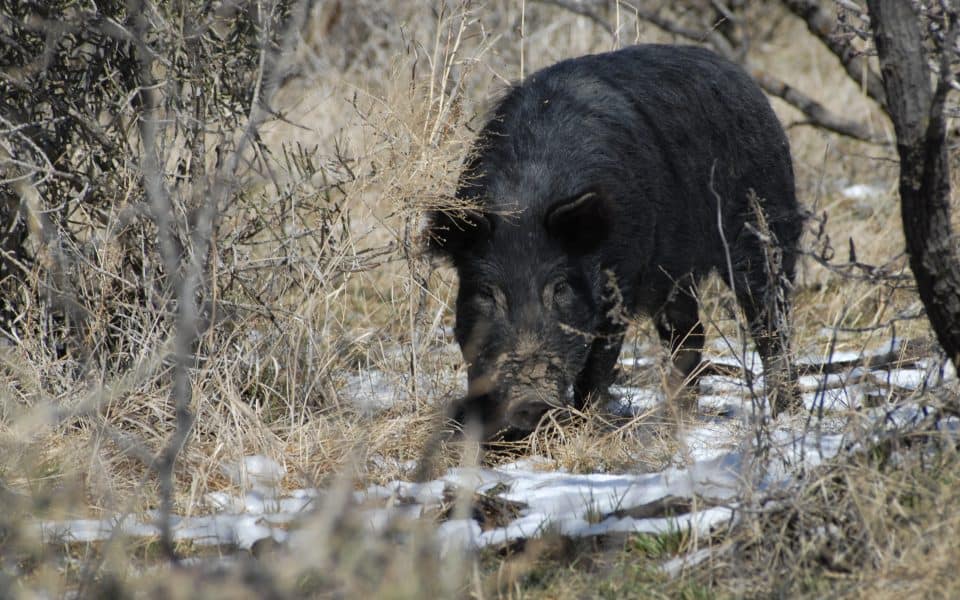Many folks believe that the extensive wild pig problem in the U.S. only concerns rural areas. But today feral hogs (Sus scrofo) are present in some suburbs and neighborhoods, rooting up golf courses, graveyards, historical sites and family gardens, carrying diseases like swine brucellosis, tularemia and tick-borne diseases, such as Lyme and Rocky Mountain spotted fever. They kill reptiles, amphibians and deer and eat the eggs of quail, turkeys, songbirds and alligators. Researchers have made startling discoveries in the last several years showing how seriously all who love the outdoors and wildlife must take the fight against wild pigs. Studies have shown wild hogs to have higher IQs than dolphins, killer whales, elephants and dogs and cause an estimated nationwide damage of up to $1.5 billion per year.

John Phillips
A Possible New Solution Wild Pigs
Dr. John Tomecek, an associate professor and extension wildlife specialist at Texas A&M University and the chair of the National Wild Pig Task Force, emphasizes that the feral pig problem has become so huge that, “Anyone who harvests feral hogs is a friend of mine. I don’t want to live in a world where you go into the woods, and all you can see are pigs and no other wildlife.”
Tomecek has done field trials for the past two years with his Texas A&M team on a warfarin-based product (a toxicant) to try to determine if it has the ability to significantly reduce wild hog populations throughout Texas at different seasons of the year. Texas is environmentally diverse with sections of the state similar to the southeastern U.S., and other parts primarily mountains, deserts, swamps, prairies and tropical environments.
“This study was a collaborative effort between the Texas A&M Agrilife Extension Service and Texas Wildlife Services and funded by the Texas legislature,” Tomecek reports. “Our legislature sets aside quite a bit of money each year to invest in feral hog management. The results have demonstrated that a warfarin-based product – Kaput Feral Hog Bait made by Scimetrics Ltd. Corp. in Wellington, Colorado – could be used to kill pigs throughout the year, thereby reducing wild pig damage. Warfarin, an anti-coagulant, is used for many things –originally to kill rats. If you’re on a blood thinner, you may be on a later generation of this anti-coagulant that has human medical applications as well.”
Dr. Tomecek and his team had no preconceived notions about whether or not the product would work. Their mission was to observe private applicators diligently putting out the warfarin in wax block form containing hog attractants, according to best accepted practices. “We learned that you had to feed warfarin to a group of pigs over five or six days for it to be effective – generally 1/2-pound of product per day per pig. But pigs ate as much as they could eat – some more and others less before succumbing to the toxicant. The wild pigs might begin dying around the seventh day, and an entire sounder might be dead by days 10 or 11.”
After the tests, the team has sent their findings to the Texas Department of Agriculture to determine whether or not this product can get a Texas registration. Since 2017, Kaput has had an EPA (Environmental Protection Agency) registration. At this writing in the fall of 2023, Tomecek doesn’t know of any state with a registration where Kaput can be used. The Texas legislature and the Texas Department of Agriculture will make the decision about what can be done with the Kaput product.
Problems Associated with High Wild Pig Numbers
Damage Caused to Livestock, Crops and Wildlife:

John Phillips
Tomecek reports that wild pigs do so much damage to so many parts of the environment. “The agricultural damage by wild pigs just in terms of destroying Texas crops is above $500 million each year. Adding in the damage to livestock, that total reaches $600 million per year. But we don’t know the amount of wild pig damage done to our wildlife, forest lands and the environment or the animals there.”
“They also compete with wildlife for critical habitat resources. In Texas, when food and water are hard to find because of a drought, many animals starve to death. However, I’ve never seen a feral hog look skinny.”
Where feral hogs have been removed, Tomecek and his team have seen damage to the land and crops reverse and disappear, and all the animals on the land become much healthier. “We need to remember that no pigs are native to the U.S. or North or South America. Our environment isn’t built for wild hogs, our wildlife can’t deal with them, and the entire U.S. landscape is far better off without feral hogs.”
Problems Impacting Water Sources:
“Once pigs get into water sources, they’ll root around and stir up the sediment there,” Tomecek says. “Wild pigs defecate in the water, spreading diseases and other pathogens by water – like E. coli. In some instances, the federal government has had to shut down a river infected with E. coli, since it wasn’t safe for humans to swim or play in it without becoming very sick.”
Other Disease Issues Involving Feral Hogs:
“Recent studies have shown that wild pigs have the ability also to move Chronic Wasting Disease (CWD) around properties,” Tomecek reports. “Wild pigs may catch CWD, and when they die, those disease associated prions will be in the ground. In Texas, we also worry about anthrax in our deer herds. A recent study shows that although pigs don’t die from anthrax, they can produce numbers of anthrax spores after they’re infected. As they run around, they’re spreading anthrax. When hunters trap wild pigs and move them to other properties to hunt them, they may think they’re like Johnny Appleseed. Actually they’re spreading diseases into new areas.”
Feral Hogs’ High Reproduction Rates at Early Ages:
“Another major problem is the feral hog’s ability to reproduce,” Tomecek says. “A six-month old sow may already have had her first litter, and then after have two to three litters per year, each with 8 to10 piglets. The pig population blows up from one sow to numbers of wild pigs in only one year.”
Wild Pigs Outfight Predators:
Tomecek mentions, “There’s no predator that can take on a sounder of feral hogs and fight them successfully. You can go to YouTube and watch a Tennessee black bear attempting to kill a feral hog. After the fight’s over, although the bear is sitting down, panting and worn out – and it still hasn’t gotten the hog. A large alligator can kill and eat a feral hog, but due to the rapidity of feral hogs reproducing, the alligators can’t keep the numbers of feral hogs under control. Wild piglets aren’t easy meals for predators either. A feral hog characteristic is all the sows in a sounder generally are related and raise their piglets collectively. If a female dies, all the other sows in that sounder raise her young collectively and protect them.”
Wild Pig Numbers Can Be Reduced

John Phillips
When Gamekeepers asked Tomecek if the Kaput Feral Hog Bait is the magic bullet to control pigs, he answered, “I’d never say that one method will control hogs that’s better or more effective then another. Trapping hogs, using toxicants like the hog bait and aerial gunning in open terrain (as in Texas) have been effective. We’re in a war with hogs and must fight using each weapon strategically to do the most damage to hog numbers.”
“Even after a bunch of pigs have been killed on a property, I’ve had mixed reports about how long before you’ll see them again. Some landowners say that killing several sounders of pigs keeps them from returning for two years. Others have found that killing a big sounder of pigs just means another sounder will move in quickly. Some folks have learned that a cooperative effort of adjacent landowners dedicated to hog removal is a very effective way to reduce wild pig numbers.”
Dr. Tomecek emphasizes that, “Attempting to remove all the feral pigs on a property isn’t a futile effort. If you don’t remove the hogs, the cost will be much higher. As Americans, we need to realize that feral hogs are cutting into all our lives – in our ability to feed people and take care of our wildlife and lands. We’re all in this fight together. Landowners who care about wildlife must get serious about removing wild hogs to keep these hogs from spreading diseases and competing for and depleting resources for our native wildlife.”
The National Park Service’s Concerns about Wild Pigs
The National Park Service has recognized the need to eliminate feral hogs from its lands. It’s hired Dr. Tomecek and his team to develop hog management plans for all the U. S. national parks and their different environments. “From the Deep South to the western states, the deserts and even Hawaii, our mission is to help the Park Service get a handle on the feral pigs already present,” Dr. Tomecek reports.
To learn more about the latest research on feral hogs, go to Texas A&M’s website – https://feralhogs.tamu.edu/.








